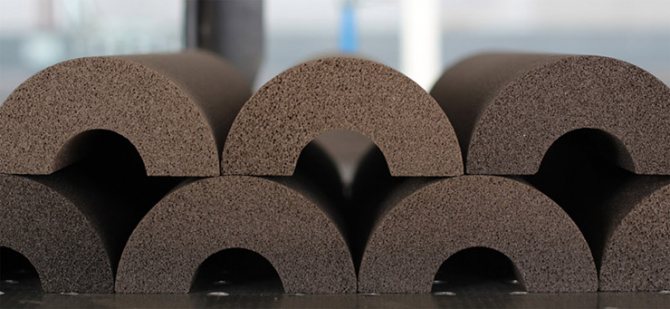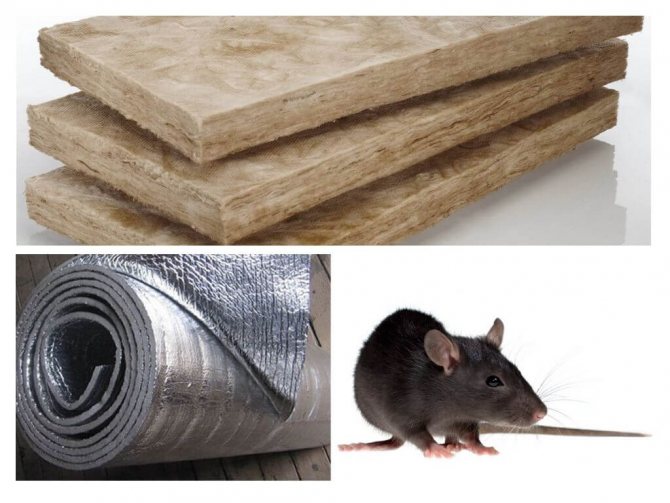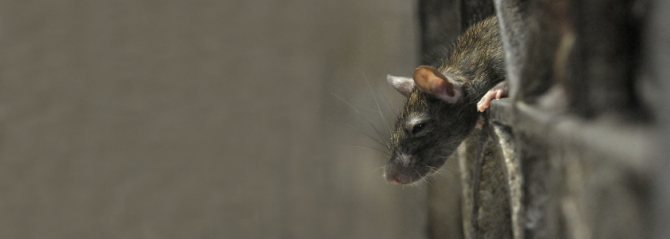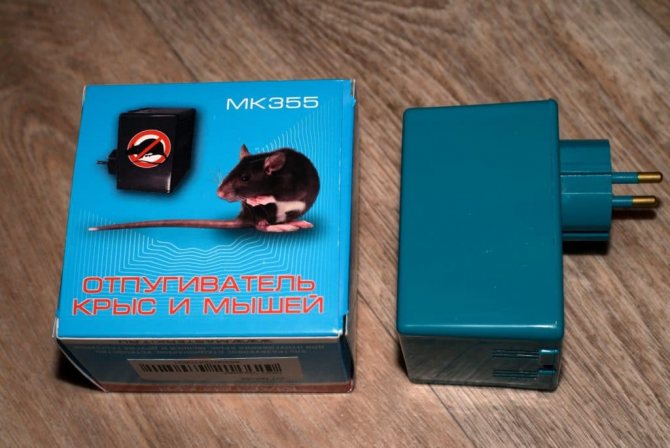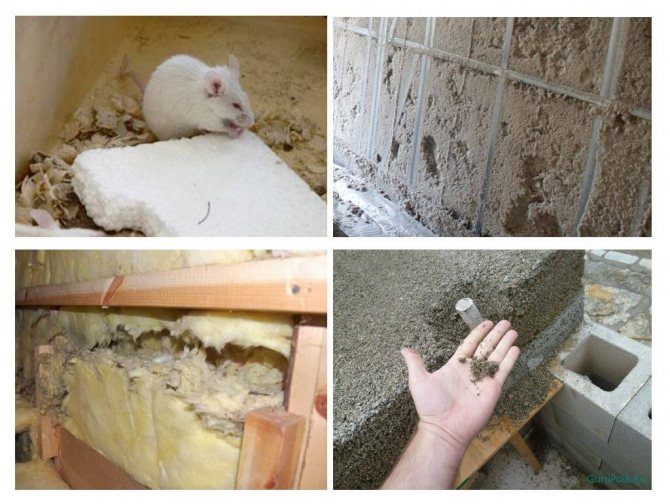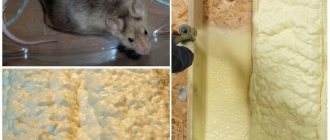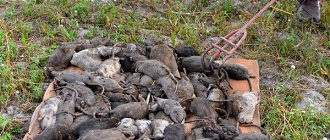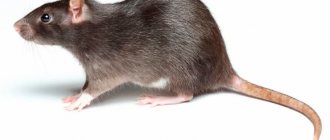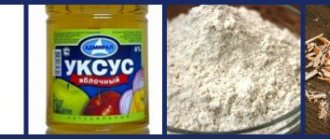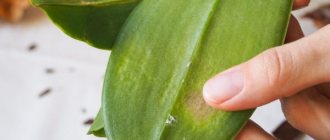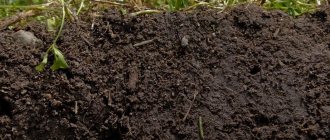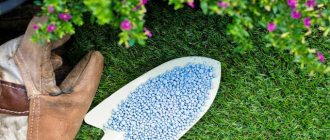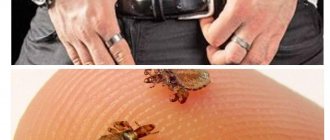Owners of private houses and cottages made of foam blocks often face the problem of insulating floors, ceilings and walls. What insulation is the highest quality, how to choose a material in which mice and rats will not start? In some heat-insulating materials, rodents live and equip warm cozy nests, gnaw through winding passages.
Mice do not eat isolation, but will gladly use it as a dwelling. In this case, the work on insulating the house does not make sense, because cold air from the street gets into the room through the holes made. This will require additional heating or renovation, which will affect the family budget.

Why do mice gnaw on inedible things, including different types of insulation?
Some types of insulation are considered conditionally edible for rodents, such as chipboard, reeds and polystyrene. By eating them, rats compensate for the prolonged lack of food. The organic materials from which the insulation is made are perfectly digested and absorbed in their stomachs. Mice can gnaw on polyurethane foam, fiberboard, MDF, polyurethane foam, and this is due to their physiological characteristics. Rodent incisors grow throughout life, so they have to be ground regularly.
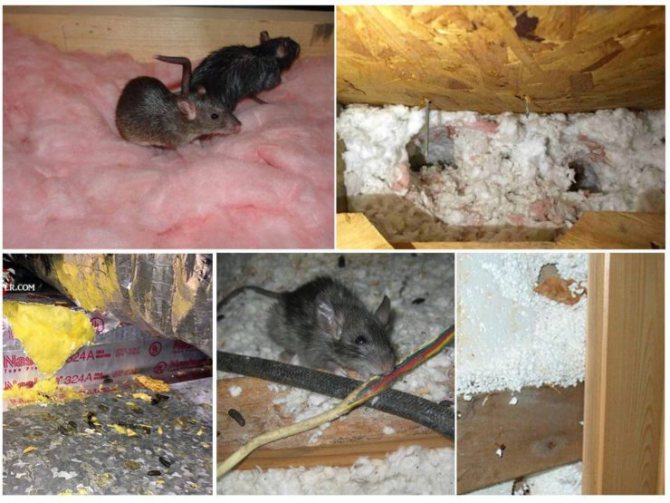

Preventing styrofoam spoilage
To provide protection from rodents for this material, you should start a cat, tighten its layer with a fine-mesh net, do not leave food and debris in the open, choose only durable grades of material for insulating your home, it is permissible to install a modern ultrasonic repeller.
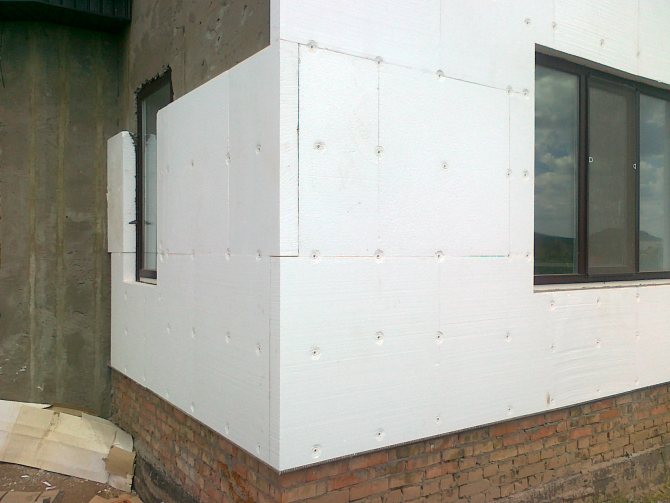

An excellent option to prevent damage to other materials will be their combination when laying. For example, you can lay "inedible" building material around the perimeter of the room, and place polystyrene or mineral wool inside. Barbed wire reinforcement is often used as a barrier. It is permissible to lay broken glass on the bottom and on top of the insulation layer.
What's too tough for mice?
In fact, there are few heaters inaccessible to rats, because they gnaw on polyurethane foam, asbestos shields, isover, geotextiles. The choice of thermal insulation for walls and floors occurs at the stage of building a house, and it must be treated with full responsibility. If mice get inside the insulation, then you won't be able to get rid of them quickly. They deliver not only psychological discomfort to the owners of the house, but also contribute to heat loss, which increases heating costs.
Cellular concrete (foam concrete)
Modern, safe and environmentally friendly material with high strength (see photo below). It is produced in the form of ready-made blocks, it contains water, cement, foaming agent and sand. Foam concrete is not subject to decay and destruction, it has high strength and durability. Thanks to air bubbles, cellular concrete blocks are lightweight and easy to install. With the help of foam concrete, you can significantly reduce heating costs, since it is able to accumulate, store and give off heat, and regulate the level of humidity in the room.
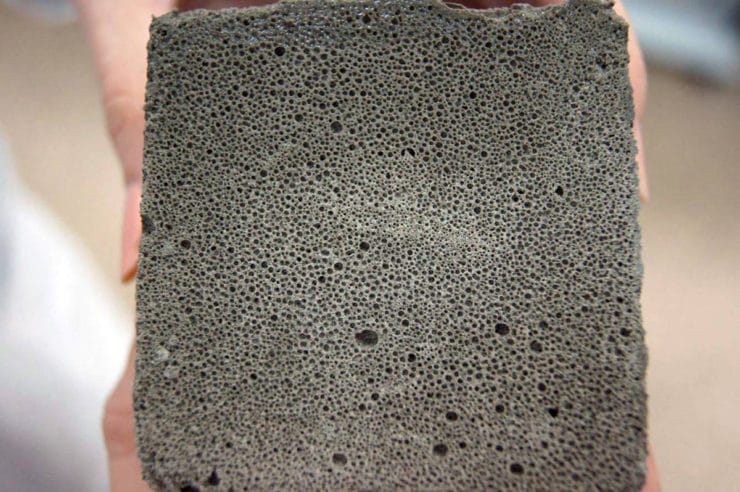

The blocks are fixed to the walls with glue, which saves on finishing materials.Fireproof and moisture-proof properties, relatively low cost and ease of use make foam concrete one of the most popular heaters. Mice and rats are not able to spoil it, but over time, subtle microcracks appear in the material, in which insects, for example ants, can settle.
Cellulose insulation (ecowool)
This is the newest modern thermal insulation material made from paper and wood waste. Ecowool is treated with phosphoric acid, which is safe for humans, and causes partial paralysis, dehydration and asthma attacks in rodents. It is interesting that the insulation is able to pass moisture, but it does not lose its heat-shielding properties. Ecowool can be used for both exterior and interior decoration.


Advantages of cellulose insulation:
- fire resistance;
- high degree of thermal insulation;
- seamless styling;
- maintaining a comfortable level of humidity in the apartment;
- sound insulating properties;
- safety and environmental friendliness.
In such material, mice or rats are not found, fungus and mold will not appear. Ecowool does not lose its insulating properties at 20% moisture, while mineral wool or polyurethane foam ceases to keep warm even at a 5% moisture level.
The only drawback of cellulose insulation is that it tends to settle if improperly installed. And it is not very convenient to apply it on the wall without special devices.
Foamed glass (foam glass)
A time-tested material, invented back in Soviet times for the needs of shipbuilding. Later it turned out that foam glass has excellent sound and heat insulating properties and can be used as a heater. It is produced in the form of granules or glass chips and in the form of monolithic blocks. It is made from molten glass with the addition of a gas-generating substance. Glass fragments and waste are used, which are fused under the influence of high temperature.
The gas released during the melting process turns into air bubbles and provides the cellular structure of the material. Foamed granulated glass looks like light gray expanded clay. Blocks are used to insulate facades, and granules and chips are suitable for floor insulation. Foam glass is highly durable and durable. Service life - more than 100 years, it is absolutely safe and meets all sanitary and environmental requirements. The advantages of using it include resistance to damage by rodents and insects, although the cost of such a heater is not affordable for everyone.
Rodent Resistant Insulation
There are materials for home insulation that are not attractive to pests or are inaccessible to their teeth. These include foam ceramics and foam glass, gas and foam concrete, expanded polystyrene concrete, vermiculite, expanded clay, perlite, ecowool, cellulose materials, drywall, linen fiber mats. Aerated concrete can be partially damaged by rats. They are able, if desired, to gnaw a little and simple concrete, but they will not be able to do much harm to the insulation material or settle in aerated concrete.


Foam glass is strong and durable, so it is not afraid of the teeth of even large rodents. Inorganic compounds, minerals and fired clay serve as protection against pests in the structure of vermiculite, perlite and expanded clay. It also includes bulk materials, it is impossible for rodents to live in them.
Vermiculite perfectly absorbs mouse odors, prompting the animals to leave the house. Ecowool is pure cellulose and can be digested by rodents. But they do not touch the material, since it contains borax or orthophosphoric acid. Linen fibers are filled with lignin, which repels gray creatures.Like orthophosphoric acid, it dehydrates them.
Drywall contains a small amount of lime and partially repels pests. If they want to, they can gnaw through the partition from it and damage the profiles.
What kind of insulation is not an obstacle for mice and rats?
We got acquainted with sustainable materials, but what kind of insulation in the house is better not to use? There are many of them, mice feel very comfortable in them. Rodents easily gnaw holes and equip nests, although they rarely use insulation for food. The most unsuccessful material for home insulation is polystyrene foam. Thorough processing of the insulation with boric acid or copper sulfate will help against pests.
Types of mineral wool: glass, stone (basalt)
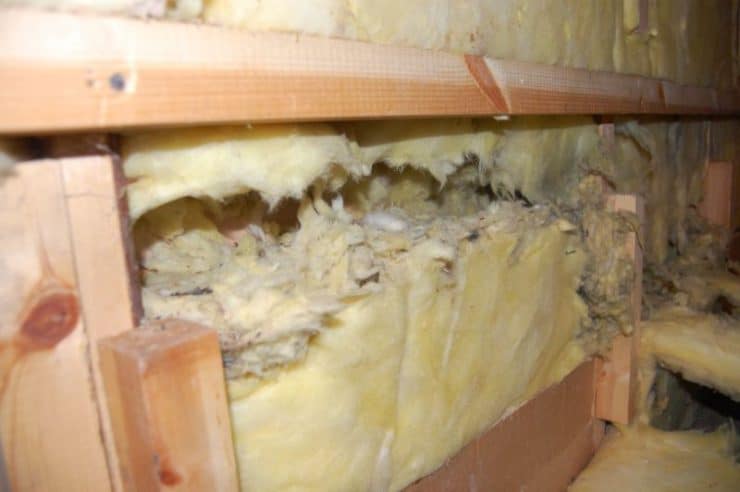

Mineral wool has high heat-insulating properties, it is obtained by processing slags and some rocks with additional impurities. One of the varieties of mineral wool is glass wool, which was widely used as a heater in Soviet times. It is elastic, durable, breathable, frost-resistant, fireproof. Fungus and mold will never appear in it, but mice often turn on. Rodents do not eat glass wool, because it is very prickly, but they easily make long passages in it and build nests.
Today, glass wool has been replaced by more durable and safer basalt (stone) wool. It is made from the remnants of rocks by rapid melting. Its soft fibrous structure, thermal conductivity and environmental friendliness make it a favorite habitat for rodents. They settle inside the material, which leads to a decrease in the quality of the thermal insulation of the house. No mineral wool is suitable for insulating living quarters.
Styrofoam and expanded polystyrene
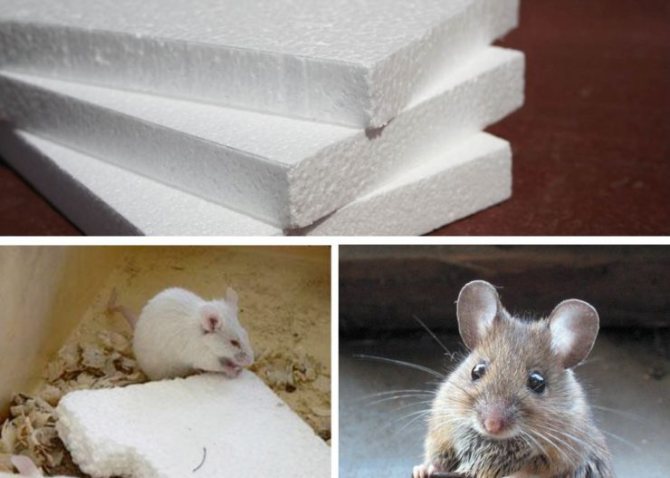

Polyfoam attracts rodents with its texture and smell; in a short time, they are able to turn up to 80% of the insulation into dust. Mice not only settle in it, but also store food supplies inside, which makes a person's stay in the room unbearable. Polyfoam is very easy to install and inexpensive, but it must be properly prepared before use. Foam boards can be covered with fine mesh metal mesh, but this is too expensive. Experienced builders advise to pour over them with a liquid concrete solution, which prevents the appearance of rodents.
Instead of foam, polystyrene foam, which is more resistant to mouse teeth, can be used. It is made from the same raw materials as foam, but using more modern technologies. Special flame retardants are added to it at high temperatures, enriched with carbon dioxide and extruded. The resulting mass is solidified and cut into slabs of the required size. Expanded polystyrene has a higher density, ease and ease of installation. It has excellent thermal insulation, resistance to moisture and frost, but the thicker the slab, the more readily rodents breed in it.
Polyurethane foam
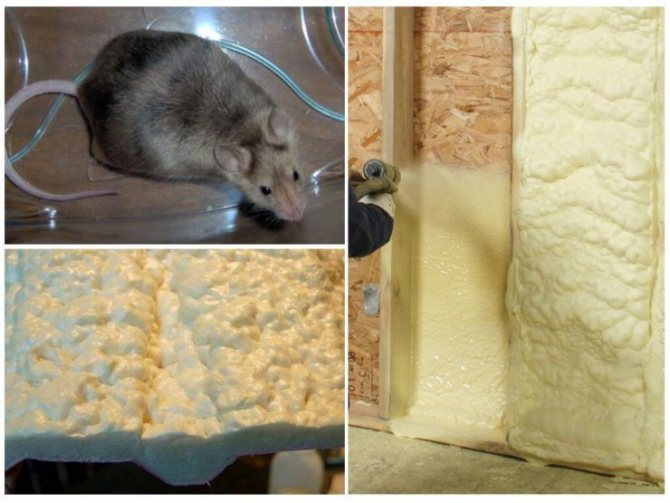

Unfortunately, the question of whether mice gnaw on foam can be answered in the affirmative. They not only grind growing teeth on it, but also grind the foam into fine dust, which is used to build nests. Inexperienced owners of private houses are trying to seal the holes made by mice and rats with foam. This empty exercise will not lead to anything, because it will not be an obstacle to rodents.
Foam rubber, roofing material and other materials
Unlike foam rubber and polyurethane foam, mice are not able to gnaw through roofing material and slate, since they are dense and hard. The only disadvantage of using roofing material is the ability to absorb odors. The disadvantage can be eliminated with the help of a film stretched over a roofing felt sheet. Instead, they often use roofing paper, the smell of which is unpleasant for rodents. It is better not to use foam rubber as insulation at all, as well as chipboard, because these materials are defenseless against the teeth of rats and mice.
The choice of insulating material begins at the stage of laying the foundation. First of all, attention is paid to its heat-conducting properties, durability, and noise protection. Environmental friendliness, fire safety and air permeability are considered an important point. From this point of view, expanded clay is an ideal insulation. There are cases when rats have damaged aluminum and lead pipes, and it will not be difficult for them to gnaw through most of the popular heaters.
Pest control products
Of course, it is very important to know what kind of insulation mice and rats do not like, but additional means of protection will not interfere at all. It is best to carry out preventive maintenance during the construction phase so as not to have problems in the future. The most popular rodent-saving techniques:
- Metal grid. A highly reliable way to protect a building. It is best to use a galvanized, fine mesh mesh. It can also be used to protect the floor.
- Boric acid. The product is used for processing chipboards. Rodents avoid boric acid, which is why manufacturers often add it to professional pest repellents.
- Folk methods. During construction, seals can be treated with ash or tobacco dust. You can also dry mint, pine branches, or wormwood. Rats and mice do not tolerate these odors. Professional builders recommend treating seals with a solution of lime or borax. You can also use hot pepper by stacking the pods along the walls.
- Ultrasound. Modern scarers are very popular, although they have some disadvantages. The device can be used if the insulation has been exposed to pests in an already built room.
- "Biological weapons". The oldest way to get rid of rodents is to get a cat. Mice immediately detect the presence of four-legged hunters and leave the territory.
High-quality thermal insulation is necessary for every private house, but not all heaters can boast of resistance against rodents. The choice of materials must be approached very carefully, because it is easier to prevent the appearance of mice and rats than to try to get rid of them later.
Do mice gnaw Penoizol?
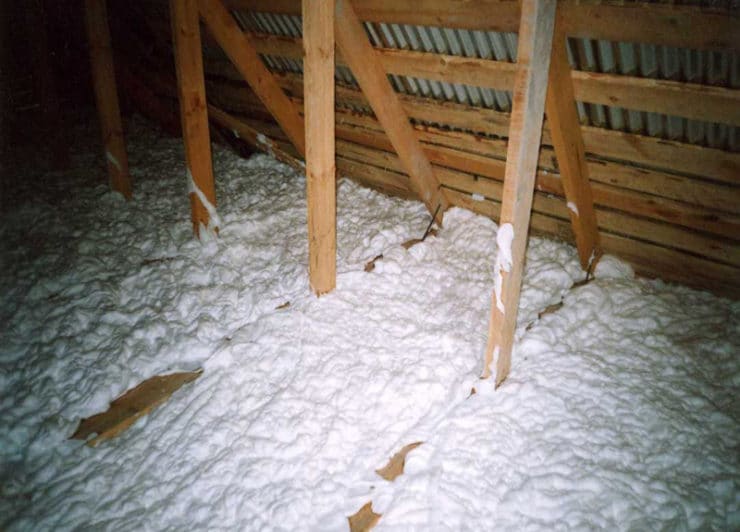

Penoizol is a unique material in which mice and harmful insects do not live, but they are quite capable of gnawing it. Penoizol is resistant to fire, easy to install, immune to temperature extremes, fungus does not start in it. In liquid form, it is used to fill cavities and voids in the foundation and floor. Hardened penoizol is widely used to insulate old wooden houses. Sometimes poisonous and dangerous for rodents formaldehyde is added to it, and it is better not to use it for interior decoration.
How to protect your home?
In order to protect your home as much as possible, always think about carefully sealing cracks and technological holes. Then any rodents will not simply have the physical ability to live in mineral wool.
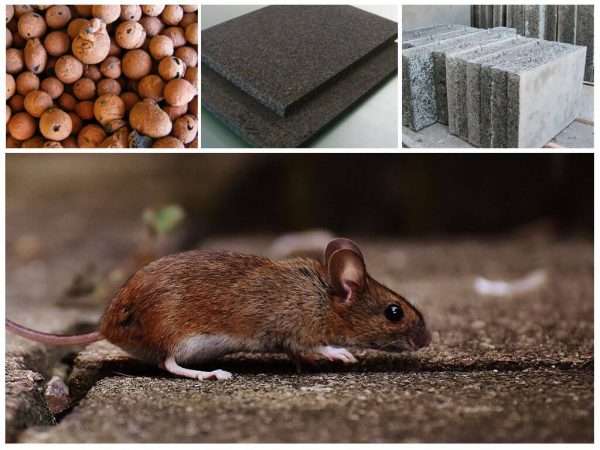

Do rodents live in minwat
Official manufacturers are silent about such a point as resistance to any rodents, they simply try to omit it. Although if you look at the numerous posts on construction forums, then the masters complain and talk about such an unpleasant moment.
So what needs to be done to create a reliable barrier that mice don't like the most? In the first place, oddly enough, is clay, which is processed according to a certain scheme and formed in granules. They really don't like such a place for their dwelling, especially if you use a small fraction. The reason is quite simple and commonplace. When rodents begin to move on unsteady surfaces. They simply fail.Among other things, being in dusty expanded clay for a long period of time, they have nothing to breathe, due to the fact that the airways are clogged. Next, let's pay attention to the foam glass. Its manufacturing technology is as follows:
- Steam the glass.
- Next comes the foaming of the glass.
When the foam glass hardens, it hardens as much as possible and does not lend itself to the teeth of rodents. Foam concrete is also widely used. It is also considered to be an excellent barrier.
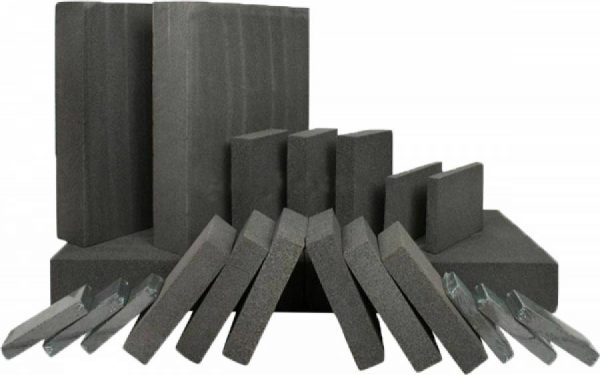

Foam glass
Solid insulation is certainly the best remedy for rodent infiltration. But at the same time, the level of its thermal indicators is an order of magnitude lower. Therefore, use and select material without relying on rodent resistance.
At the stage of construction work, think over everything to the smallest detail and build reliable protective barriers.
Ways to fight
If rodents have already appeared in the house, they damage building materials, build nests in it, numerous moves, the question arises of how to get rid of mice in insulation. Initially, you should destroy pests, and only then start restoring walls, floors, ceilings, increasing protection.
The use of poison is not the best option. The poison does not work immediately. Death occurs within 5 days. There is a high probability of death of a rodent in a layer of insulation. Then an unpleasant cadaveric smell will spread throughout the house. Regarding modern drugs with a mummifying effect, the smell is still present, although not as strong.
The most optimal way to control rodents is to catch or expel. They use folk methods, physical, attract natural enemies of rodents.



